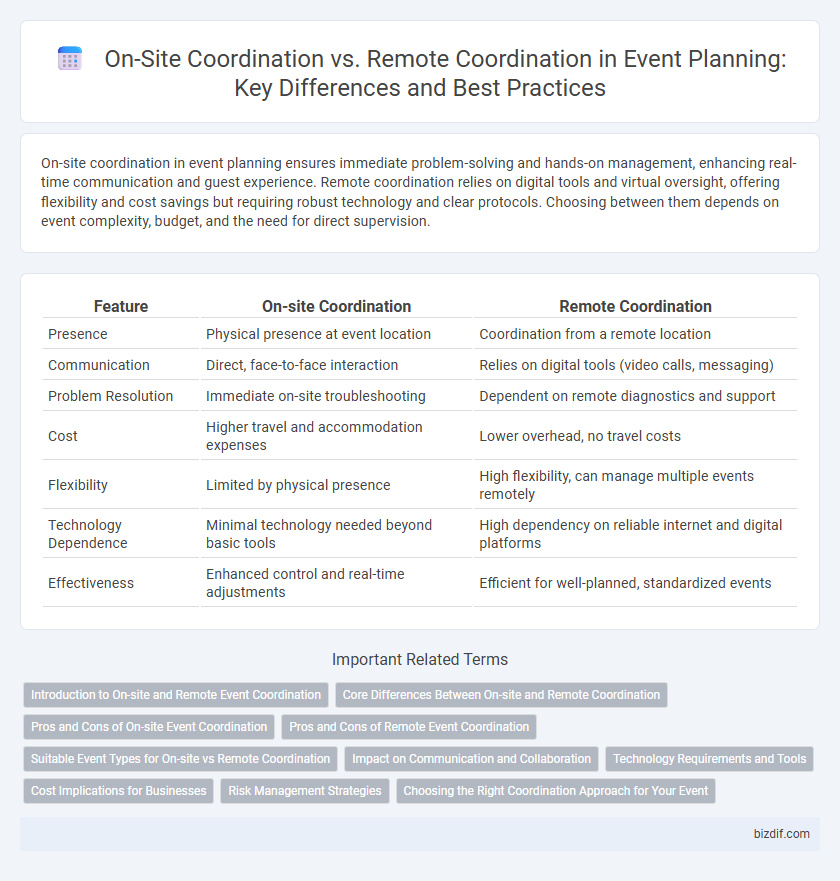On-site coordination in event planning ensures immediate problem-solving and hands-on management, enhancing real-time communication and guest experience. Remote coordination relies on digital tools and virtual oversight, offering flexibility and cost savings but requiring robust technology and clear protocols. Choosing between them depends on event complexity, budget, and the need for direct supervision.
Table of Comparison
| Feature | On-site Coordination | Remote Coordination |
|---|---|---|
| Presence | Physical presence at event location | Coordination from a remote location |
| Communication | Direct, face-to-face interaction | Relies on digital tools (video calls, messaging) |
| Problem Resolution | Immediate on-site troubleshooting | Dependent on remote diagnostics and support |
| Cost | Higher travel and accommodation expenses | Lower overhead, no travel costs |
| Flexibility | Limited by physical presence | High flexibility, can manage multiple events remotely |
| Technology Dependence | Minimal technology needed beyond basic tools | High dependency on reliable internet and digital platforms |
| Effectiveness | Enhanced control and real-time adjustments | Efficient for well-planned, standardized events |
Introduction to On-site and Remote Event Coordination
On-site event coordination involves managing logistics, vendors, and guest experiences directly at the event location, ensuring immediate problem-solving and real-time adjustments. Remote event coordination leverages digital tools and communication platforms to oversee event planning and execution from a distance, optimizing efficiency and reducing travel costs. Both methods require strong organizational skills and clear communication to deliver successful event outcomes.
Core Differences Between On-site and Remote Coordination
On-site coordination involves managing event logistics directly at the venue, allowing for immediate problem-solving and real-time oversight of vendors, staff, and setup, which enhances responsiveness and control. Remote coordination relies on digital communication tools, enabling planners to manage multiple events simultaneously but often limiting the ability to address unforeseen issues promptly. The core differences lie in the physical presence and hands-on management of on-site coordination versus the flexibility and reliance on technology that characterize remote coordination.
Pros and Cons of On-site Event Coordination
On-site event coordination offers direct control over logistics, immediate problem-solving, and enhanced communication with vendors and staff, ensuring smooth execution and real-time adjustments. However, it requires physical presence, which can increase travel costs, limit multitasking ability, and pose challenges in managing multiple locations simultaneously. On-site coordinators provide valuable hands-on oversight but may face fatigue and reduced flexibility compared to remote options.
Pros and Cons of Remote Event Coordination
Remote event coordination offers cost savings by eliminating travel and accommodation expenses while enabling access to a broader talent pool for event management experts. However, challenges include limited real-time problem-solving capabilities and potential communication delays that can impact event flow and attendee experience. Leveraging advanced collaboration tools and detailed pre-event planning can mitigate some risks associated with remote coordination.
Suitable Event Types for On-site vs Remote Coordination
On-site coordination is ideal for high-touch events such as weddings, conferences, and large-scale exhibitions where immediate problem-solving and personal interaction are crucial. Remote coordination suits smaller meetings, virtual conferences, and hybrid events that rely heavily on digital tools and require less physical presence. Choosing the appropriate coordination style depends on event size, complexity, and the need for real-time, face-to-face communication.
Impact on Communication and Collaboration
On-site coordination fosters real-time, face-to-face communication, enhancing immediate feedback and dynamic collaboration among event teams. Remote coordination relies heavily on digital tools and virtual meetings, which can introduce delays and miscommunication due to lack of physical presence. Effective communication in on-site settings typically leads to quicker decision-making and smoother problem resolution compared to remote coordination's dependence on technology and scheduling.
Technology Requirements and Tools
On-site coordination demands reliable communication devices such as walkie-talkies, event management software, and real-time scheduling tools to ensure seamless interaction among staff. Remote coordination relies heavily on cloud-based platforms like Zoom, Trello, and Slack for virtual collaboration, task tracking, and instant updates. Both approaches require robust internet connectivity and security protocols to maintain smooth operations and data integrity throughout the event.
Cost Implications for Businesses
On-site coordination requires businesses to allocate budget for travel, accommodation, and per diem expenses, increasing the overall event costs. Remote coordination reduces overhead by minimizing logistical expenditures and allows for flexible staffing, leading to significant cost savings. However, businesses must invest in reliable technology platforms and communication tools to ensure seamless remote event management.
Risk Management Strategies
On-site coordination enhances risk management by allowing immediate response to unexpected issues, direct supervision, and real-time communication with vendors and staff, reducing the likelihood of miscommunication and delays. Remote coordination relies heavily on technology and virtual tools, requiring robust contingency plans and clear protocols to mitigate risks such as connectivity failures and delayed decision-making. Effective event planners implement hybrid strategies that combine on-site presence with remote oversight to optimize risk mitigation and ensure seamless event execution.
Choosing the Right Coordination Approach for Your Event
On-site coordination offers real-time problem solving and immediate access to vendors, ensuring seamless event execution in dynamic environments. Remote coordination leverages digital tools to streamline communication and reduce costs while maintaining flexibility for managing multiple or geographically dispersed events. Evaluating factors such as event size, complexity, budget, and location will help determine the most effective coordination approach for your specific needs.
On-site coordination vs Remote coordination Infographic

 bizdif.com
bizdif.com